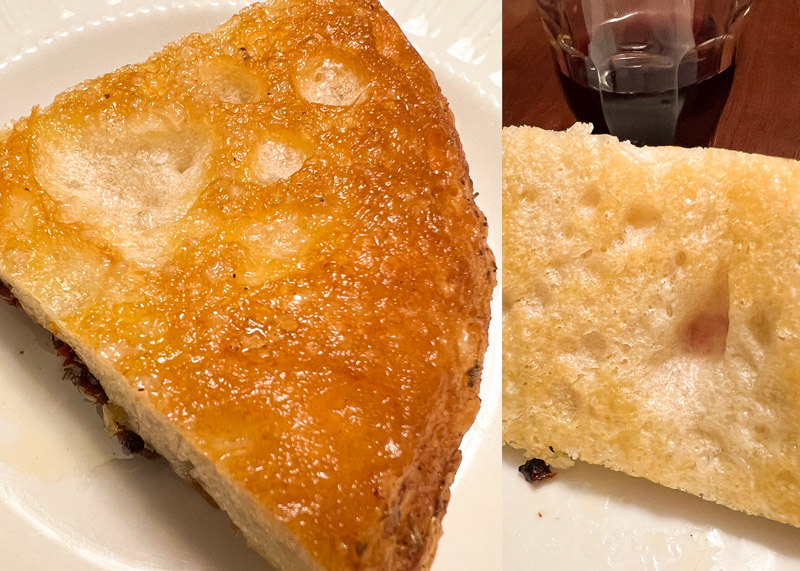Ratings, percentages, and more
rating: 5/8 slices

hydration: 80%

difficulty: moderate

Ingredient percentages
| Ingredient | Standard % | Baker’s % |
| Flour (567g) | 54% | 100% |
| Salt (11g) | 1.04% | 1.95% |
| Yeast (4g) | 0.38% | 0.7% |
| Water (454g) | 43.28% | 80% |
| Olive Oil (14g) | 1.33% | 5% |
Summary
- Interesting pizza, but not nearly as good as Reinhart’s Detroit style.
- Could not get a crisp crust.
Here’s the book I pulled this recipe from
Initial Thoughts
I’ve been working through all the styles in Peter Reinhart’s book: Perfect Pan Pizza. So far the results have ranged from amazing — Detroit style — to disastrous — grandma style. In making the Roman style,* I continued to have issues achieving a crisp crust in my Nordicware aluminum sheet pan on the first day I bake the pizza.
*Through reading, not experience, I've learned there are two distinct styles of pizza prevalent in Rome. Al taglio and tonda (or pizza romana). Al taglio is a bit like a really long sheet pan pizza (although not always backed in a pan), cut to a customer specified size, and sold by weight. It's often eaten for lunch. Tonda is a round pizza with a very thin and crisp crust that's popular for dinner. Reinhart's recipe aims to recreate al taglio on a home oven scale.
When I made Reinhart’s Classic Redstripe Detroit style pizza, I was impressed. I had high hopes that all the styles used in the book would match, or at least come close to this one. The book has 5 styles of pizza: Detroit, focaccia, schiacciata, Sicilian, grandma, and Roman. All use the same dough recipe but treat it slightly differently when it comes to panning and the final rise. The Detroit version is one of my all time favorites. The others I’ve made so far (focaccia, grandma, and Roman) I’d rate as decent to unacceptable. However, I suspect that part of the issue may be my pan, which seems to struggle to get a crispy crust.
The Experience
This isn’t meant to be a book review though, so let’s get back to my experience with the Rossa Roman pizza. As I’m sure I’ve mentioned, in my wife’s eyes, it’s not pizza unless there’s pepperoni. So, I made half of the pizza per the recipe and the other half with cheese and pepperoni.

In a surprising twist both my wife and I preferred the half made per the recipe, which only calls for a simple sauce, with oregano sprinkled on after it comes out of the oven. No cheese. No pepperoni. Somehow the simple flavors just work so well together. I guess that’s why this style has a following.
While we both liked the flavor of the sauce only rossa pizza, the best pizza of the night was my own concoction, made in a non-stick pie pan with the excess dough. I laid down an herb oil base, roughly adopted from the book. Then I added some chopped sun-dried tomatoes, havarti cheese, and topped it off with some cooked bacon leftover from breakfast. Havarti melts well and has a nice, stretchiness, similar to mozzarella. The tomatoes and chili pepper flakes in the oil, added a great accent to the richness of the other toppings, while the bacon crisped up well and gave it some texture and that incomparable bacon flavor.

The toppings were the highlights of the pizzas. The crust was fine. Soft and bread like. (I should add that I mixed in about 100 grams of all-purpose flour instead of using all bread flour as the recipe calls for — maybe this led to a softer, less chewy result.) The sheet pan cooked crust had no crisp and bent over when held only by the crust. This, even though I cooked it on the high end of the recommended cooking time.
I continue to struggle to understand where I am going wrong with these pizzas that fail to crisp and get that nice golden-colored exterior. The recipe contemplates some time out of the oven to add the sauce, which you do after a 5-minute-topping-free bake. However, it was probably out slightly longer than the recipe contemplated as I added also added cheese and pepperoni to one half. Additionally, I noticed that the finished product is not uniformly thick. Maybe I need to do better evenly distributing the dough while spreading the dough out in the dimpling process. Still, if a lack of uniform dough distribution is the culprit, I’d expect to find the thinner areas crisp and the thicker ones not, while here I actually found no part of the crust is crisp. Another possibility is that I’m letting the dough rise in the pan a little too long. I’ve been mostly going by the recommended times in the book, which results in the dough climbing slightly higher up the pan than the recipe says it should by the end of the second rise.

Interestingly, the crust cooked in the non-stick pie pan came out much better than the one made in the sheet pan made per the recipe. So, maybe the pan itself is the issue here. One final possibility is the parchment paper. I question these last two as the cause because the book suggests using parchment paper and most pictures show these pizzas made in aluminum sheet pans similar to mine. Bottom line: I’m still not sure why that sheet pan is giving me so much trouble. I’d love to hear thoughts if anyone has them.
Additional Cooking Notes
I mostly followed the recipe aside from my previously noted addition of a little over 100 grams of all-purpose flour in place of bread flour. Also, I realized that with both this pizza and at least one other I’ve made with this same recipe, I added the oil to the dough after the 5 minute rest that’s required for the dough to fully hydrate. The recipe actually says to add the oil, after the initial mixing of the flour, salt, yeast, and water. Letting it hydrate before adding the oil, probably impacts how the dough absorbs the oil. I need to make sure I follow this part of the recipe next time and see if it changes anything.

The recipe calls for dimpling the dough right before putting it in the oven for the initial 5-minute-sauceless bake. I assume the dimples help to collect and create pockets of sauce and dough, but the recipe doesn’t specify their purpose. I had hoped that the 5-minute par bake would give the crust the head start it needed to crisp up, but, as I show above, that wasn’t the case.
Cold
Decent flavor. No crunch. Bready. May be that the addition of all purpose made it feel especially soft, almost mushy. Cold not recommended.
Day Two Reheat
I reheated at 460 for about 12 minutes. I did one with no added oil and the other with a little oil added to the aluminum foil I reheated it on. Both were from the sheet pan pizza that I couldn’t get crisp on day one. Both came out nicely crisp on the reheat. The one with no oil, bordered on being too crisp. The oiled version was excellent, crisp, but not in a way that you risk hurting the roof of your mouth if you bite it wrong.
So, as with the focaccia, day two came out better for the Rossa Roma. Maybe I should bake them the day before I plan to serve and then reheat the day of service. I think some of these recipe’s are based on pizzas that, after an initial bake, are placed in a display case and, when selected by a customer, reheated. So, this might be what the originators designed these crusts for. What does it taste like on day three though — the third reheat?
Wrap Up
Once again, the crust in the initial bake underwhelmed, while the reheated crust impressed. While I currently can’t recommend spending the time to make this, I will probably make this again —primarily because I want to figure out what I’m doing wrong on the first day. I will definitely continue to make pizzas, although maybe with a different crust, using the sauce only and sauceless topping combo I used here.
Lessons
Bacon makes it better…
